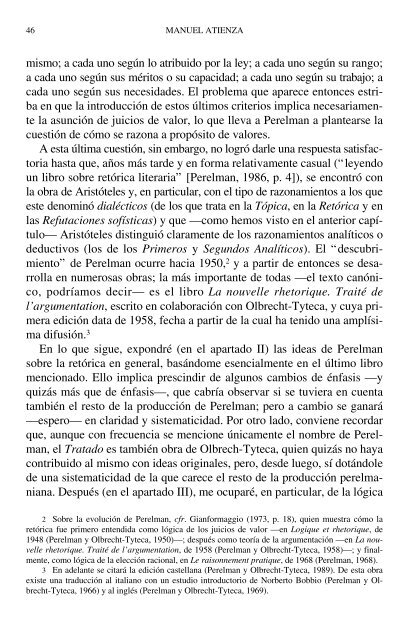LAS RAZONES DEL DERECHO Teo rías de la ar gu men ta ción ju rí di ca
You also want an ePaper? Increase the reach of your titles
YUMPU automatically turns print PDFs into web optimized ePapers that Google loves.
46 MANUEL ATIENZA<br />
mismo; a <strong>ca</strong>da uno según lo atribuido por <strong>la</strong> ley; a <strong>ca</strong>da uno según su rango;<br />
a <strong>ca</strong>da uno según sus méritos o su <strong>ca</strong>pacidad; a <strong>ca</strong>da uno según su trabajo; a<br />
<strong>ca</strong>da uno según sus necesida<strong>de</strong>s. El problema que ap<strong>ar</strong>ece entonces estriba<br />
en que <strong>la</strong> introduc<strong>ción</strong> <strong>de</strong> estos últimos criterios impli<strong>ca</strong> neces<strong>ar</strong>ia<strong>men</strong>te<br />
<strong>la</strong> asun<strong>ción</strong> <strong>de</strong> <strong>ju</strong>icios <strong>de</strong> valor, lo que lleva a Perelman a p<strong>la</strong>nte<strong>ar</strong>se <strong>la</strong><br />
cuestión <strong>de</strong> cómo se razona a propósito <strong>de</strong> valores.<br />
A es<strong>ta</strong> última cuestión, sin emb<strong>ar</strong>go, no logró d<strong>ar</strong>le una respues<strong>ta</strong> satisfactoria<br />
has<strong>ta</strong> que, años más t<strong>ar</strong><strong>de</strong> y en forma re<strong>la</strong>tiva<strong>men</strong>te <strong>ca</strong>sual (“leyendo<br />
un libro sobre retóri<strong>ca</strong> liter<strong>ar</strong>ia” [Perelman, 1986, p. 4]), se encontró con<br />
<strong>la</strong> obra <strong>de</strong> Aristóteles y, en p<strong>ar</strong>ticu<strong>la</strong>r, con el tipo <strong>de</strong> razonamientos a los que<br />
este <strong>de</strong>nominó <strong>di</strong>alécticos (<strong>de</strong> los que tra<strong>ta</strong> en <strong>la</strong> Tópi<strong>ca</strong>, en <strong>la</strong> Retóri<strong>ca</strong> y en<br />
<strong>la</strong>s Refu<strong>ta</strong>ciones sofísti<strong>ca</strong>s) y que —como hemos visto en el anterior <strong>ca</strong>pítulo—<br />
Aristóteles <strong>di</strong>stin<strong>gu</strong>ió c<strong>la</strong>ra<strong>men</strong>te <strong>de</strong> los razonamientos analíticos o<br />
<strong>de</strong>ductivos (los <strong>de</strong> los Primeros y Se<strong>gu</strong>ndos Analíticos). El “<strong>de</strong>scubrimiento”<br />
<strong>de</strong> Perelman ocurre hacia 1950, 2 y a p<strong>ar</strong>tir <strong>de</strong> entonces se <strong>de</strong>s<strong>ar</strong>rol<strong>la</strong><br />
en numerosas obras; <strong>la</strong> más impor<strong>ta</strong>nte <strong>de</strong> todas —el texto <strong>ca</strong>nónico,<br />
pod<strong>rí</strong>amos <strong>de</strong>cir— es el libro La nouvelle rhetorique. Traité <strong>de</strong><br />
l’<strong>ar</strong><strong>gu</strong><strong>men</strong><strong>ta</strong>tion, escrito en co<strong>la</strong>bora<strong>ción</strong> con Olbrecht-Tyte<strong>ca</strong>, y cuya primera<br />
e<strong>di</strong><strong>ción</strong> da<strong>ta</strong> <strong>de</strong> 1958, fecha a p<strong>ar</strong>tir <strong>de</strong> <strong>la</strong> cual ha tenido una amplísima<br />
<strong>di</strong>fusión. 3<br />
En lo que si<strong>gu</strong>e, expondré (en el ap<strong>ar</strong><strong>ta</strong>do II) <strong>la</strong>s i<strong>de</strong>as <strong>de</strong> Perelman<br />
sobre <strong>la</strong> retóri<strong>ca</strong> en general, basándome esencial<strong>men</strong>te en el último libro<br />
<strong>men</strong>cionado. Ello impli<strong>ca</strong> prescin<strong>di</strong>r <strong>de</strong> al<strong>gu</strong>nos <strong>ca</strong>mbios <strong>de</strong> énfasis —y<br />
quizás más que <strong>de</strong> énfasis—, que <strong>ca</strong>b<strong>rí</strong>a observ<strong>ar</strong> si se tuviera en cuen<strong>ta</strong><br />
<strong>ta</strong>mbién el resto <strong>de</strong> <strong>la</strong> produc<strong>ción</strong> <strong>de</strong> Perelman; pero a <strong>ca</strong>mbio se gan<strong>ar</strong>á<br />
—espero— en c<strong>la</strong>ridad y sistematicidad. Por otro <strong>la</strong>do, conviene record<strong>ar</strong><br />
que, aunque con frecuencia se <strong>men</strong>cione úni<strong>ca</strong><strong>men</strong>te el nombre <strong>de</strong> Perelman,<br />
el Tra<strong>ta</strong>do es <strong>ta</strong>mbién obra <strong>de</strong> Olbrech-Tyte<strong>ca</strong>, quien quizás no haya<br />
contribuido al mismo con i<strong>de</strong>as originales, pero, <strong>de</strong>s<strong>de</strong> luego, sí dotándole<br />
<strong>de</strong> una sistematicidad <strong>de</strong> <strong>la</strong> que c<strong>ar</strong>ece el resto <strong>de</strong> <strong>la</strong> produc<strong>ción</strong> perelmaniana.<br />
Después (en el ap<strong>ar</strong><strong>ta</strong>do III), me ocup<strong>ar</strong>é, en p<strong>ar</strong>ticu<strong>la</strong>r, <strong>de</strong> <strong>la</strong> lógi<strong>ca</strong><br />
2 Sobre <strong>la</strong> evolu<strong>ción</strong> <strong>de</strong> Perelman, cfr. Gianformaggio (1973, p. 18), quien muestra cómo <strong>la</strong><br />
retóri<strong>ca</strong> fue primero enten<strong>di</strong>da como lógi<strong>ca</strong> <strong>de</strong> los <strong>ju</strong>icios <strong>de</strong> valor —en Logique et rhetorique, <strong>de</strong><br />
1948 (Perelman y Olbrecht-Tyte<strong>ca</strong>, 1950)—; <strong>de</strong>spués como teo<strong>rí</strong>a <strong>de</strong> <strong>la</strong> <strong>ar</strong><strong>gu</strong><strong>men</strong><strong>ta</strong><strong>ción</strong> —en La nouvelle<br />
rhetorique. Traité <strong>de</strong> l’<strong>ar</strong><strong>gu</strong><strong>men</strong><strong>ta</strong>tion, <strong>de</strong> 1958 (Perelman y Olbrecht-Tyte<strong>ca</strong>, 1958)—; y final<strong>men</strong>te,<br />
como lógi<strong>ca</strong> <strong>de</strong> <strong>la</strong> elec<strong>ción</strong> racional, en Le raisonne<strong>men</strong>t pratique, <strong>de</strong> 1968 (Perelman, 1968).<br />
3 En a<strong>de</strong><strong>la</strong>nte se cit<strong>ar</strong>á <strong>la</strong> e<strong>di</strong><strong>ción</strong> <strong>ca</strong>stel<strong>la</strong>na (Perelman y Olbrecht-Tyte<strong>ca</strong>, 1989). De es<strong>ta</strong> obra<br />
existe una traduc<strong>ción</strong> al i<strong>ta</strong>liano con un estu<strong>di</strong>o introductorio <strong>de</strong> Norberto Bobbio (Perelman y Olbrecht-Tyte<strong>ca</strong>,<br />
1966) y al inglés (Perelman y Olbrecht-Tyte<strong>ca</strong>, 1969).



